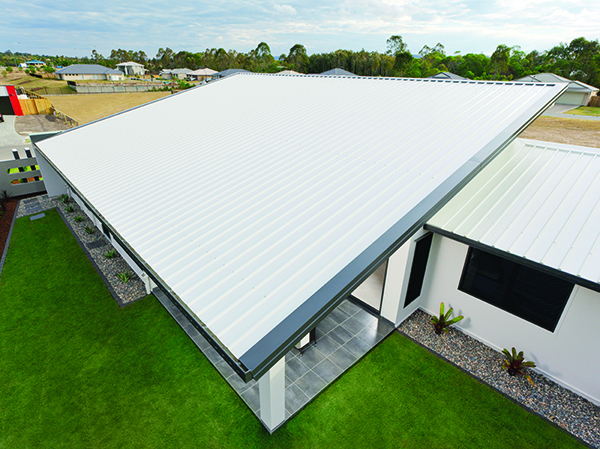Including everything from solar tiles to an all-in-one insulated roofing system, this selection of the latest roofing products reflects the on-going, industry-wide emphasis on sustainability, innovation, and quality.
As ever, the assessment of new roofing materials – indeed any building materials – involves a range of considerations. These include the aesthetic appeal of the products and the ways they facilitate and expand design choices; their functionality and the ways in which they make things easier for those who live and work in their presence; whether or not they are easy to work with and help simplify or speed up construction and installation tasks; and of course, cost.
Increasingly these days, assessment of the quality of new roofing systems, methods and materials also involves consideration of their sustainability. Specifiers on the lookout for new products need to ask themselves how they affect the project’s carbon footprint, as well as questions around their production, product stewardship, and so forth.
Insulated roofing systems
When it comes to assessing the ways construction projects, and indeed households, can reduce carbon emissions, the installation of home insulation is not just one of the most obvious steps but also one of the most likely to have a meaningful effect.
To put a figure on this, according to the Victorian Government, when used appropriately in residential applications, insulation can reduce energy usage and its associated cost by 40 – 50%. Considering this effectiveness, the only other question is which type of insulation to choose. With a product range that includes everything from ceiling batts to partition insulation and thermal breaks, the options are many.
Increasingly, over the last 20 years or so, all-in-one insulated roofing systems have grown in popularity. Products like Bondor’s InsulRoof and SolarSpan work by creating thermal barriers over the home, and in so doing, improving thermal performance and reducing reliance on HVAC systems.
Suitable for residential applications, these products combine insulation and ceiling in one cost-effective and easy to use product. Manufactured and engineered locally, they replace traditional timber roof trusses and metal or tiled roofing, with a smarter all-in-one roof system.

From a design perspective, this makes higher ceilings as well as more open and spacious living areas possible, while at the same time, ensuring faster construction times and simplified project management.
Lightweight and only 1m wide, Bondor’s insulated roof panels interlock together over the existing wall structure. For this reason, because they are light and easy to work with, installation on the average residential roof takes less than a day. And, on top of that, because they effectively replace four individual products (roof trusses, ceiling, insulation and roof sheeting) with a single panel, specifying them helps minimise waste and reduce transport requirements.
Bondor’s SolarSpan was recently included in a new ‘off-the-grid’ house at Cedar Creek in the Samford Valley west of Brisbane. Specified along with solar panels, a waste treatment system and 45,000 litre rainwater tanks, the insulated roofing system met the ‘self-sufficiency’ brief perfectly.
Beyond that, considering the general isolation of the site, the fact that SolarSpan is a pre-fabricated system was another clear plus. It meant that the need for deliveries was minimised. Combined with the simple installation process, it helped ensure the job was completed smoothly and without undue fuss.
Now complete, the mid-century modern-inspired four-bedroom home benefits from the easy elegance of the ceiling’s underside, while at the same time, the simple skillion pitch roof allows the roofline to follow and blend in with the natural sloping contour of the site.
Solar tiles
Another roofing product deserving of the ‘sustainable’ tag – though for completely different reasons – is Volt, a state-of-the-art solar tile from Bristile Roofing.
Volt is engineered to integrate seamlessly into residential projects. Designed by Leeson Group with matte-black glass and a sleek black aluminium frame, along with a busbar-free design, the tile eliminates white grid-like lines usually seen on standard solar panels, allowing Volt to blend effortlessly with adjacent roof tiles.
Volt uses a unique Metal Wrap Through (MWT) cell technology and a busbar-free design to increase the efficiency of solar cells, creating a seamless look on rooftops when installed. The Volt solar tiles are the world’s first solar tiles that can generate the equivalent amount of energy as a standard solar panel. The 115W MWT mono PERC Planum module has a market-leading 18.8% solar efficiency and the Volt Lodge solar tile 105 MWT mono PERC module has a solar efficiency of 19.4%.
While, in environmental terms, these credentials are impressive, as Brett Ward, General Manager International Marketing, Brickworks points out Volt represents more than just a tick for sustainability.
“Customers are becoming increasingly discerning about the products they invest in, and so whilst sustainability is high on the priority list, they also don’t want to compromise on style,” he says.
“Dedicated to providing energy independence to homes through beautifully designed solar tile systems, Volt provides a quality, sustainable product with a seamless design that won’t impact the home’s aesthetic and curb appeal.”
Paired with Bristile’s Planum, Prestige, Premiere and Eton profiles, the solar tiles have a unique interlocking system to ensure waterproofing. The interlocking tiles create a neat, minimalistic look on the roof while generating clean, independent energy for the home.
According to Ward, Volt solar tiles provide opportunity for many more Australians to make with switch to renewable energy.
“Volt is a great example of what can be achieved through thoughtful innovation and the genuine desire to make the world a better place, and I believe this product will pave the way for a new generation of quality, sustainable roofing products,” he said.
Solar powered roof ventilators
Effective roof ventilators are another effective means of driving heat from residential roof cavities, reducing reliance on HVAC systems, and addressing carbon reduction ambitions.
Most often this involves the installation of simple wind vents – units that (in the case of standard 250mm vents) are able to move about 85-100m³ of air per hour. Similar in terms of effectiveness to removing a space the size of a single tile from the roof, these units require the installation of six to eight units for the average house to be worthwhile.

With levels of effectiveness that have been measured to exceed this, Solatube’s solar powered roof ventilators are an attractive alternative to standard roof vents. To quantify that, when installed in a typical house, a single solar powered system is able to outperform six to eight of the standard wind vents mentioned above.
As their name implies, solar powered roof ventilators employ electricity generated by their own solar panels to operate highly efficient fan units. Products available from Solatube are available with a range of accessories, including thermal switches, add-on solar panels, and a variety of flashing options. They represent a highly effective means to protect roof spaces during the cooler winter months, and drive heat and moisture out of roof cavities all year round.
In this way, by removing excess humidity produced by showers, humidifiers, dishwashers, and so forth, they reduce the potential for mould and help prevent leaks and the structural decay of roofs.
Beyond that, as the ongoing COVID experience has taught us, effective ventilation as provided by products like solar powered roof ventilators is an effective means of reducing the transmission of viruses and contributing to a healthier internal environment. Similarly, such systems are a wise choice for installation in bush fire prone areas where the quality of air can be compromised by smoke and associated toxins.
Gutter guards
Grayson’s Gutter Guard is another company with ideas in terms of bushfire mitigation. The toughest, most resilient product in the company’s range, it is specifically designed to stop small bushfire embers from entering gutters and roofing.
Unlike similar products, the Bushfire Ember Gutter Guard features a mesh material that is woven rather than moulded. During the manufacturing process each strand is separated from the one next to it, then these strands are cut and then re-joined in the grid pattern with innovative weaving machinery.
The mesh, itself, is made from aluminium strands and features openings that measure just 2mm x 2mm. As such, it is ideal for blocking dangerous bushfire ambers from entering roofs, without affecting the gutters’ ability to divert rainwater.

On top of that, in order to eliminate fraying and create an appropriate edge for fixing screws, the edges of the mesh are folded to form a hen. Then, as a final step, the Bushfire Ember Gutter Guard is finished with a powder coat to match the specific roof colour.
The resulting product, which is non-combustible and manufactured according to specifications recommended by the Victorian Building Authority, is suitable for installation even in the most bushfire prone areas as set out in the Bushfire Attack Level (BAL) guidelines. These include the extremely high-risk BAL-40 and BAL-FZ (Flame zone) locations.
Images: Bondor
SUPPLIERS:
Bondor
Bristile Roofing
Solatube
Grayson’s Gutter Guard

